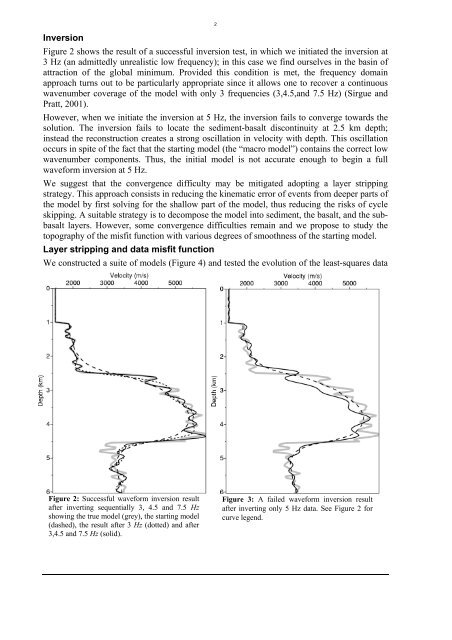p177 feasibility of full waveform inversion applied to sub ... - Earthdoc
p177 feasibility of full waveform inversion applied to sub ... - Earthdoc
p177 feasibility of full waveform inversion applied to sub ... - Earthdoc
You also want an ePaper? Increase the reach of your titles
YUMPU automatically turns print PDFs into web optimized ePapers that Google loves.
2InversionFigure 2 shows the result <strong>of</strong> a successful <strong>inversion</strong> test, in which we initiated the <strong>inversion</strong> at3 Hz (an admittedly unrealistic low frequency); in this case we find ourselves in the basin <strong>of</strong>attraction <strong>of</strong> the global minimum. Provided this condition is met, the frequency domainapproach turns out <strong>to</strong> be particularly appropriate since it allows one <strong>to</strong> recover a continuouswavenumber coverage <strong>of</strong> the model with only 3 frequencies (3,4.5,and 7.5 Hz) (Sirgue andPratt, 2001).However, when we initiate the <strong>inversion</strong> at 5 Hz, the <strong>inversion</strong> fails <strong>to</strong> converge <strong>to</strong>wards thesolution. The <strong>inversion</strong> fails <strong>to</strong> locate the sediment-basalt discontinuity at 2.5 km depth;instead the reconstruction creates a strong oscillation in velocity with depth. This oscillationoccurs in spite <strong>of</strong> the fact that the starting model (the “macro model”) contains the correct lowwavenumber components. Thus, the initial model is not accurate enough <strong>to</strong> begin a <strong>full</strong><strong>waveform</strong> <strong>inversion</strong> at 5 Hz.We suggest that the convergence difficulty may be mitigated adopting a layer strippingstrategy. This approach consists in reducing the kinematic error <strong>of</strong> events from deeper parts <strong>of</strong>the model by first solving for the shallow part <strong>of</strong> the model, thus reducing the risks <strong>of</strong> cycleskipping. A suitable strategy is <strong>to</strong> decompose the model in<strong>to</strong> sediment, the basalt, and the <strong>sub</strong>basaltlayers. However, some convergence difficulties remain and we propose <strong>to</strong> study the<strong>to</strong>pography <strong>of</strong> the misfit function with various degrees <strong>of</strong> smoothness <strong>of</strong> the starting model.Layer stripping and data misfit functionWe constructed a suite <strong>of</strong> models (Figure 4) and tested the evolution <strong>of</strong> the least-squares dataFigure 2: Successful <strong>waveform</strong> <strong>inversion</strong> resultafter inverting sequentially 3, 4.5 and 7.5 Hzshowing the true model (grey), the starting model(dashed), the result after 3 Hz (dotted) and after3,4.5 and 7.5 Hz (solid).Figure 3: A failed <strong>waveform</strong> <strong>inversion</strong> resultafter inverting only 5 Hz data. See Figure 2 forcurve legend.
















